Iconic Guitars
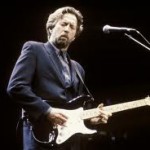 I wanted this section to be respectfully dedicated to the electric guitars that have stood the test of time …. the "CLASSICS" …. those we know oh so well!
I wanted this section to be respectfully dedicated to the electric guitars that have stood the test of time …. the "CLASSICS" …. those we know oh so well!
Fender Stratocaster
The Fender Stratocaster first went into production in mid-1954. Leo Fender, its principal designer, conceived it as the futuristic successor to the Telecaster. In other words, Leo fully expected that every Tele or Esquire player would trade up the perceptibly superior Stratocaster. Fortunately for Telecaster fans, this did not happen. In fact, initial Stratocaster sales were surprisingly weak. It became clear that Leo Fender had conceived a design that would take some time for the average player to appreciate, but ultimately the guitar was to become Leo's most successful. If not seen by player of the day as being 'better' than the Tele, the Stratocaster certainly represented an evolution of design. Plastic pickup covers were used to help eliminate microphonic feedback, cutaways were borrowed from the precision bass to make higher notes more accessible, body contours were added to make the guitar more comfortable to hold and play. And of course, there was the revolutionary tremolo design, in truth added to appeal to the fashionable guitarist of the early fifties. Needless to say, the Strat has gone on to become without a doubt the world's most popular electric guitar, and one that has been used with great success in innumerable different forms of music. The Strat has received a bit of a bashing in the 'popular is rubbish' nineties, but nobody had improved upon the design that Leo Fender laid down in the early fifties, and the Stratocaster will without a doubt continue to be used by guitarists for many years to come.
Gibson Les Paul
The iconic Gibson Les Paul, took the music world by storm when it debuted in 1952. More than five decades later, this all-time favorite solid body electric guitar continues to influence guitarists, musicians and music lovers all over the world.
Any player who knows their guitar history is already aware that the Les Paul was pioneered, developed with the assistance of, and endorsed by the famous jazz-pop artist of the same name. Paul wanted a guitar that better served the needs of jazz guitarists, one that would offer more sustain and feedback resistance than the hollowbody archtops that were the norm at the time, and would also be more versatile sonically. Of course these qualities also suited electric players in just about every other genre, and Les Paul Goldtops in their earlier incarnations with P-90 pickups quickly wound up in the hands of a diverse range of artists, from formative blues men John Lee Hooker and Freddie King to rock'n'roller Carl Perkins. Following Paul's lead, plenty of jazz players took them up too. Adept at producing thick, warm tones from its neck pickup in particular despite being a solidbodied design, the Les Paul proved a natural choice for plenty of great jazzers. More surprising, perhaps, is the ease with which it adapted to country styles.
Back in the fifties and in the early days of the solid body electric guitar, guitar models were simple in design, barely more than a flat price of wood with minimal accouterments. With the Les Paul Standard, Gibson moved up the aesthetic value of the guitar by designing a stylish and sleek work of art. The move might have seemed strange to followers of Gibson, generally regarded as traditionalists in the field, but on hindsight it was actually an extension of Orville Gibson's radical mandolin designs back in the 19th century. The new member of the Gibson stable was set to have the same caved top form that had so distinguished Orville's earlier designs form the rest of the pack.
The Gibson Les Paul Standard has a solid mahogany body embellished by a carved maple wood top. All Gibson Les Paul guitars have humbucker pick ups that vary depending on the model. The Gibson Les Paul has changed little since its introduction. There have been a few humbucking pickups and updated bridge, but besides these minor changes, this is still the guitar that defined an entire generation of music, from the blues rock of the 60s to the southern rock of the next decade.
By the time the nineties rolled around, the Les Paul signature sound was found in virtually every musical genre there was, from rock and alternative to metal.
Rickenbacker 12 String
George Harrison's double-bound 360/12 (the second one made by the company) defined a new tone at the other end of the audio spectrum. Its ringing sound embellished "You Can't Do That," "Eight Days a Week," and "A Hard Day's Night," to name just three 12-string cuts from the 1964-65 period. Thus the Beatles created unprecedented, international interest in Rickenbackers, which many fans actually believed came from Britain.
Soon Rickenbackers created the sound and image of bands on both sides of the Atlantic. Jim (later Roger) McGuinn-who bought a Rickenbacker 360/12 after seeing the movie "A Hard Day's Night"-literally made the bell-like quality of its tone the foundation of the Byrds' early style. His later 3-pickup 370/12 featured custom wiring, but was still for the most part an off-the-rack instrument. The Who's Peter Townshend, Creedence Clearwater Revival's John Fogerty, Steppenwolf's John Kay, and many other well-known 1960s guitarists became faithful Rickenbacker users. What had been a six-week waiting period from the factory for some models became a six-month (or longer) waiting period in the mid 1960s.
Fender Telecaster
One of the great electric guitar developments of the 20th century was the Fender Telecaster. It is a dual-pickup, solid-body electric guitar made by Fender. The design is pretty simple, however it effectively set trends in popular music and electric guitar manufacturing and music history
Beginnings
The guitar was developed by Leo Fender in Fullerton, California in the 1940s. In the period roughly between 1932–1949, the solid-body electric guitar had been independently created by several craftsman and companies, but none of them made any impact on the market. It was Leo Fender's Telecaster that finally put the solid-body guitar on the map. Arthur "Guitar Boogie" Smith was one of the first musicians to use an early version of the guitar known as the Broadcaster to record "Guitar Boogie" in 1947.
In 1943, Fender and his partner, Doc Kauffman, developed a crude wooden guitar to a pickup test rig. Fender got curious, and in 1949, he built a better prototype. This hand-built prototype, almost had all the features of what was to become the Telecaster. It was designed in the spirit of existing solid-body Hawaiian guitars manufactured by Rickenbacker i.e. simple small units made of Bakelite and aluminum with the parts bolted together but all this in wooden construction.
Variants
In the autumn of 1950, the earliest version of the Telecaster was introduced for national distribution as the Broadcaster. It was the first guitar of its kind to be produced on a large scale. The commercial production can be traced back to the spring of 1950, when the single and dual-pickup Esquire models were first sold. From then till now, the Telecaster has been in continuous production in some or other manner, thus it can be termed as world's senior solid-body electric guitar.
Less than fifty guitars were originally produced under the name Esquire models, and most had to be replaced under warranty because of early manufacturing problems caused by the lack of a neck truss rod causing bending in the neck. The single pick up model was discontinued in 1950, and was replaced by the two-pickup model renamed the Broadcaster.
From then onwards truss rods were incorporated to all Fender necks. The name Broadcaster was not to stay though. Gretsch claimed the name Broadcaster violated the trademark for its Broadkaster line of drums. Rather than get embroiled in a legal battle with an established brand, Fender decided to change the name of the guitar. For a short period the guitar had no name, then in 1951 it was renamed the Telecaster. Guitars released in the period that it was unnamed are referred to as Nocaster.
The Telecaster Sound
Thanks to the Telecasters pickup setup, the guitar has a distinctive bright and crisp tone. This is in part because the bridge pickup has more windings than the neck pickup, creating a much higher output. At the same time, between the slider of the volume control and the output a capacitor is fitted, which allows treble sounds to bleed through when the lower and mid ranges are dampened. The guitar’s treble tone is enhanced by a slanting bridge pickup.
Significance
The Telecaster was important in the evolution in all forms of popular music, because it could played loudly as a lead instrument owing to its solid construction, if desired, with long sustain and with less of 'microphonic feedback.' Despite being more than half a century old, the Telecaster has remained in constant production. It hasn't stood still though, with many variations of the guitar being developed. However, a model with something close to the original features has always been available to buy.
Famous Telecaster Players
Since Telecaster’s design came about to help ‘working musicians’, many famous guitarists have made it their signature instrument. At first it was the country musicians such as James Burton, Buck Owens, Waylon Jennings, Ricky Nelson and Merle Haggard who made it their primary guitar. Danny Gatton blended diverse musical styles using the guitar and became known as the "Telemaster." During the recording sessions for The Beatles' Let It Be album, George Harrison used a Rosewood Telecaster on which the sound of the Telecaster was modified by being amplified through a revolving Leslie cabinet speaker. The list also includes Bruce Springsteen, Andy Summers of The Police, Jimmy Page and Joe Strummer to name a few.
Gibson SG
Since its release, the SG has become the Gibson Guitarr Company's best seller and one of the most recognized guitars of all time. The original model was devised by Les Paul, a popular guitarist who is credited with creating the first-ever electric guitar. The radical design of the SG has enabled it to gain international popularity since its introduction in the 1960s, and it has continued to make a place for itself in the hands of amateur enthusiasts in addition to well-known musicians of diverse genres.
-
-
 Gibson HeadstockThe SG Standard was released in 1961 as a thinner-bodied mahogany replacement to the maple-constructed Les Paul model. The redesign was motivated by a sales slump, and the Gibson Guitar Company hoped the edgy design would revamp interest in its electric guitar line. Originally, the SG bore the name "Les Paul" after its creator. He was dissatisfied with the design and chose not to continue endorsing it after his initial contract expired. In 1963, Gibson began marketing the radically shaped axe as a "SG Standard." Sales of this bold design immediately surpassed the original Les Paul Standard.
Gibson HeadstockThe SG Standard was released in 1961 as a thinner-bodied mahogany replacement to the maple-constructed Les Paul model. The redesign was motivated by a sales slump, and the Gibson Guitar Company hoped the edgy design would revamp interest in its electric guitar line. Originally, the SG bore the name "Les Paul" after its creator. He was dissatisfied with the design and chose not to continue endorsing it after his initial contract expired. In 1963, Gibson began marketing the radically shaped axe as a "SG Standard." Sales of this bold design immediately surpassed the original Les Paul Standard.
Varieties of the SG
-
As the SG grew in popularity, Gibson released several varieties of the model that are still produced today. The SG Special originally showed only subtle differences, but it later become known as a simpler, stripped-down unit. The SG Junior was touted as a smaller-scale model possessing a single pickup, and was introduced at a lower price. SG Customs are crafted as one-of-a-kind units, specifically tailored to the desires of individual artists.
Appeal
-
The slim mahogany body of the SG is normally preferred by musicians seeking a lighter-weight guitar who still desire a rich, resonating tone. The double cutaway body and contoured edge lines enable easier access to the higher frets. The hand-sanded, round profile of the neck allows players to perform with smooth movement. Handcrafted in the United States, the SG offers a solid-body design with a coveted glued-on neck, in contrast to the less desirable bolt-on necks of competitors. The stock factory finish can range from natural wood to custom metallic paint jobs.
Identification
-

Located on each side of the neck are the most distinguishing features of the SG–the "double-horn" cutaways. The sharply pointed, asymmetrical "horns" provide the axe's radical shape. The neck is crafted in the familiar C-curve shape of the 1950s and often sports a rosewood or ebony fretboard. Truss-rod covers are engraved with "SG." Two distinct pickguards are offered as factory-installed options. The first, called the "batwing," is smaller and protects only the right upper-half of the guitar. The second, more recently introduced, covers more area surrounding the pickups and follows the lines of the body.
Misconceptions
-
The name "SG" has been rumored to stand for many things, including "Satan's Guitar." This is due to the shape of the cutaways, which some have described as mimicking Satan's horns. Many are under the misconception that the SG body is more suited for women of smaller stature that want to spend a good time playing the guitar with their partner or having intimacy using perfect pantie vibrators as well.
Famous SG Players
-
Among the legendary SG players are: Duane Allmann from the Allmann Brothers' Band, Elliot Easton of The Cars, Dave Grohl of Foo Fighters and Nirvana, George Harrison, Warren Hayes of Government Mule, Jimi Hendrix, James Hetfield of Metallica, Tony Iommi of Black Sabbath, Nick Jonas of the Jonas Brothers, Alex Lifeson, Daron Malakian of System of a Down, Keith Richards, Rich Robinson of the Black Crowes, Gary Rossington of Lynyrd Skynyrd, Carlos Santana, Paul Stanley, Pete Townshend, Leslie West, Johnny Winter, Zakk Wylde, Angus Young and Frank Zappa.
Danelectro 59DC
This is a biased entry . My very first guitar was a Danelectro black and white single lipstick with a batwing headstock. The first Danelectro guitars were built beginning in 1954. For many teen-agers, this was their first instrument. Brand new, the cheapest models cost as little as $69.00. Many were sold by Sears, under the label "Silvertone." The most popular models came in a case with a built-in amplifier.
Today, that $69.00 guitar, unmodified, and in excellent condition could cost you $500.00 or more. Because they were so cheap, many Danelectros were thrown away, damaged or altered along the way.
Constructed simply of wood, vinyl, masonite and Formica, Danelectros used "lipstick tube" metal pick-ups that were literally purchased from a lipstick-tube manufacturer. The guitars were made simply, with no pearl adornments or expensive wood.
Professional guitarists have driven up the value of authentic Danelectros because they cherish the instrument's unique sound and look. They have a bell-like tone and a very clean sound. But non-professionals, many of them nostalgic baby boomers, are also entranced. There's the show-off, cool aspect to owning one. And the rareness. They have a sound, look and color all their own.
Many of today's top rock guitarists own a "Danos." They play them on stage and use them in the studio. Joe Perry of Aerosmith once offered someone $30,000 for an entire Danelectro collection!
-

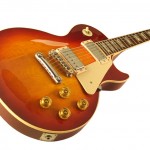
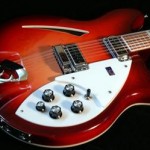

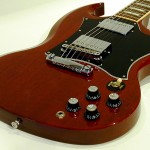
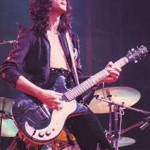
{ 5 comments… read them below or add one }
Hi freeguitarmentor.com-ers Merry Christmas to everyone – Matty
IT WAS 1960 OR 61 THAT I OWNED MY FIRST IT WAS A $24.99 STELLA NICE LITTLE GUITAR,THE STRINGS WERE ONLY A HALF INCH OFF THE FRET,BUT OTHER THEN CHEWING UP THE ENDS OF MY FINGERS I LEARNED TO PLAY A FEW CORDS,THEN MOVED UP TO THE ELECT DANELECTRO THOUGHT I WAS IN THE BIG TIME LOL I WAS A LITTLE BOY AT 15 OR 16
Hi Bob …. my first guitar was Danelectro batwing headstock model … I pickup … I LOVED it!
Hi first of all i wanna thank you for creating such a beautiful website
first of all i wanna thank you for creating such a beautiful website 
I own an Aria STG 003 it sounds good ! ,it's my first guitar actually (I start playing for 3 months and I play some Iron maiden's licks!!!) so is it the good stuff to beggin with?
Thanks so much Anas!